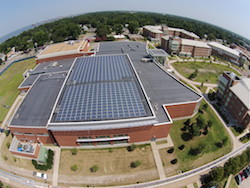Petrixo Oil & Gas will be using the Honeywell UOP Renewable Jet Fuel Process to produce renewable jet fuel and renewable diesel at a new refinery scheduled to be built in Fujairah United Arab Emirates. The technology will process around 500,000 metric tons per year of multiple renewable feedstocks into Honeywell Green Jet Fuel and Honeywell Green Diesel.
 Earlier this year, Petrixo announced that it will invest $800 million to build the new refinery, which will have a design capacity of 1 million tons per year of biofuel products, and will be the first commercial-scale renewable jet fuel production facility outside of North America.
Earlier this year, Petrixo announced that it will invest $800 million to build the new refinery, which will have a design capacity of 1 million tons per year of biofuel products, and will be the first commercial-scale renewable jet fuel production facility outside of North America.
“Petrixo believes that new energy solutions are immensely important for scalable, environmental and renewable solutions,” said Dr. Eid Al Olayyan, chief executive officer of Petrixo Oil & Gas. “UOP’s green fuels technologies are proven refining solutions that produce high-quality products compatible with petroleum-based fuels.”
The UOP technology is designed to provide flexibility to adjust the feedstock mix depending on parameters such as cost and availability. The technology also enables the adoption of newer-generation feedstocks, such as oils derived from algae and halophytes, as scalable supply chains for these lipids develop.
“UOP’s renewable process technologies produce real fuels, rather than fuel additives such as biodiesel, that fit seamlessly into existing fuel supply chains,” explained Veronica May, vice president and general manager of UOP’s Renewable Energy and Chemicals business unit. “The renewable fuels produced by our technology also offer lower greenhouse gas emissions relative to traditional petroleum-based fuels.”
Blended up to 50 percent with petroleum-based jet fuel, Honeywell Green Jet Fuel requires no changes to aircraft technology, meets all critical specifications for flight, and can reduce greenhouse gas emissions by 65 to 85 percent compared with petroleum-based fuels.










 ars, the Intersolar AWARD program has singled out landmark projects in North America that represent major technological, economical and environmental achievements,” said Markus Elsässer, CEO of Solar Promotion International, an organizer of Intersolar North America. “This year’s winners demonstrated how well designed systems that utilize the latest technologies to deliver cost-effective solar energy could benefit a variety of customer requirements. These projects, from off-grid applications to mid-sized systems to utility-scale installations, highlight solar energy’s versatility and show that the industry is well on its way toward maturation.”
ars, the Intersolar AWARD program has singled out landmark projects in North America that represent major technological, economical and environmental achievements,” said Markus Elsässer, CEO of Solar Promotion International, an organizer of Intersolar North America. “This year’s winners demonstrated how well designed systems that utilize the latest technologies to deliver cost-effective solar energy could benefit a variety of customer requirements. These projects, from off-grid applications to mid-sized systems to utility-scale installations, highlight solar energy’s versatility and show that the industry is well on its way toward maturation.”
